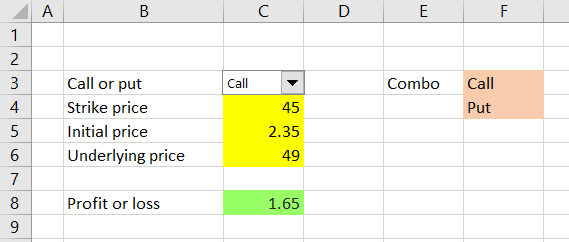

> To exercise and sell the underlying when the option is in the money. Your maximum gain as a put buyer is the strike price minus the premium. To reach breakeven point, the price of the option should decrease to cover the strike price minus the premium already paid. > Pay a certain premium for holding the right to exercise.Īs a Put Buyer, your maximum loss is the premium already paid for buying the put option.

> Have the right to sell the underlying at a certain price (strike) for a period of time. > To increase yield by selling calls against positions held long. What is your main objective as a call seller? > If the underlying price decreases, option expires worthless and the seller will keep the premium as the maximum profit attributed to this trade. > In case the call option is exercised by the buyer of the call, then the seller has the obligation to deliver the underlying with a potential of unlimited loss. Your maximum gain as a call seller is the premium already received. To reach breakeven point, the price of the option should increase to cover the strike price in addition to premium already paid. > Will be willing to see the underlying price decreasing.Īs a call seller your maximum loss is unlimited. > Will receive a premium for that obligation to sell > Assume the obligation to sell the underlying when the call buyer exercises his option. > To hedge a Short position on the same underlying. > To speculate on the potential rise in the price of an underlying instrument. What are your two main objectives as a call buyer? > You can walk away and not exercise the option. >Trade the option also when the option is in the money. > To exercise and buy the underlying when the option is in the money. Your maximum gain is unlimited as a call buyer given the fact that there is no ceiling to price increase. To get to a point where your loss is zero (breakeven) the price of the option should increase to cover the strike price in addition to premium already paid. >Acquire the right but not the obligation to buy the underlying at a certain price (strike) for a period of timeĪs a call Buyer, your maximum loss is the premium already paid for buying the call option.

Although Options are important tools for hedging and risk management, traders could end up losing more than the cost of the option itself.īelow is a summary of how options function. What’s important to note with options trading, is that investors should clearly define the benefits and risks of each and every position they enter into ahead of time. They can be used to hedge, speculate or simply as insurance. Options were created to manage one thing, risk.

> PUT Option:Gives the owner the right, but not the Obligation, to sell a particular asset at a specific price, on or before a certain time. > CALL Option: Gives the owner the right, but not the obligation, to buy a particular asset at a specific price, on or before a certain time. There are two types of Options that can be bought (Long) and sold (Short): Options are simply a legally binding agreement to buy and/or sell a particular asset at a particular price (strike price), on or before a specified date (maturity date).


 0 kommentar(er)
0 kommentar(er)
